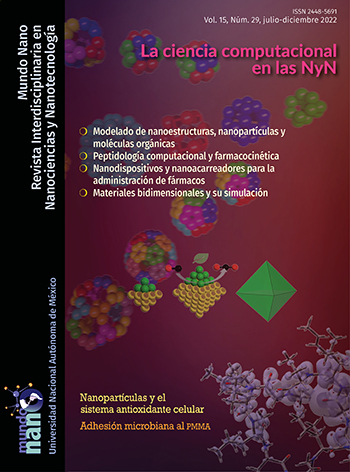Modeling 13 Archimedean solids by an object-oriented language
Contenido principal del artículo
Resumen
The computational study of structures with chemical relevance is preceded by its modeling in such manner that no calculations can be submitted without the knowledge of their spatial atomic arrangement. In this regard, the use of an object-oriented language can be helpful both to generate the Cartesian coordinates (.xyz file format) and to obtain a ray-traced image. The modeling of chemical structures based on programming has some advantages with respect to other known strategies. The more important advantage is the generation of Cartesian coordinates that can be visualized easily by using free of charge software. Our approach facilitates the spatial vision of complex structures and make tangible the chemistry concepts delivered in the classroom. In this article an undergraduate project is described in which students generate the Cartesian coordinates of 13 Archimedean solids based on a geometrical/programming approach. Students were guided along the project and meetings were held to integrate their ideas in a few lines of programmed codes. They improved their decision-making process and their organization and collecting information capabilities, as much as their reasoning and spatial depth. The final products of this project are the coded algorithms and those made tangible the grade of learning/understanding derived of this activity.
Descargas
Detalles del artículo

Mundo Nano. Revista Interdisciplinaria en Nanociencias y Nanotecnología, editada por la Universidad Nacional Autónoma de México, se distribuye bajo una Licencia Creative Commons Atribución-NoComercial 4.0 Internacional.
Basada en una obra en http://www.mundonano.unam.mx.
Citas
Ball, W. W. R. and Coxeter, H. S. M. (1987). Mathematical Recreations and Essays, 13th ed. New York: Dover, 138-139.
Eddaoundi, M.; Kim, J.; Wachter, J. B.; Chae, H. K.; O’Keeffe, M.; Yaghi, O. M. (2001). Porous metal-organic polyhedra: 25 Å cuboctahedron constructed form 12 Cu2(CO2)4 paddle-wheel building blocks. Journal of the American Chemical Society. 123: 4368-4369. https://doi.org/10.1021/ja0104352 DOI: https://doi.org/10.1021/ja0104352
Gupta, S.; Corbett, J. D. (2012). BaAuxZn13-x: Electron-Poor Cubic NaZn13-Type intermetallic and its ordered tetragonal variant. Inorganic Chemistry. 51: 2247-2253. https://doi.org/10.1021/ic2022787 DOI: https://doi.org/10.1021/ic2022787
Hayami, W.; Otani, S. (2011). Structural stability of boron clusters with octahedral and tetrahedral symmetries. Journal of Physical Chemistry A. 115: 8204-8207. https://doi.org/10.1021/jp204115x DOI: https://doi.org/10.1021/jp204115x
Haymet, A. D. J. (1985). C120 and C60: Archimedean solids constructed from sp2 hybridized carbon atoms. Chemical Physics Letter. 122: 421-424. https://doi.org/10.1016/0009-2614(85)87239-0 DOI: https://doi.org/10.1016/0009-2614(85)87239-0
Hudson, T. S. (2010). Dense sphere packing in the NaZn13 structure type. The Journal of Physical Chemistry C. 114: 14013-14017. https://doi.org/10.1021/jp1045639 DOI: https://doi.org/10.1021/jp1045639
Jabobo-Fernández, Jimena M.; Tlahuice-Flores, A. (2021). Effect of the charge state on the structure of the Au60 cluster. Physical Chemistry Chemical Physics. 23: 442-448. https://doi.org/10.1039/D0CP04393A DOI: https://doi.org/10.1039/D0CP04393A
Kim, D. Y.; Im, S. H.; Park, O. Ok, Lim, Y. T. (2010). Evolution of gold nanoparticles through Catalan, Archimedean and Platonic solids. CrystEngComm, 12: 116-121. https://doi.org/10.1039/B914353J DOI: https://doi.org/10.1039/B914353J
Kittel, C. (1996). Introduction to solid state physics, 8th ed. New York: John Wiley & Sons.
Kong, X.-J.; Ren, Y.-P.; Long, L.-S.; Zheng, Z.; Huang, R.-B.; Zheng, L.-S. (2007). A keplerate magnetic cluster featuring an icosidodecahedron of Ni(II) ions encapsulationg a dodecahedron of La(III) ions. Journal of the American Chemical Society. 129: 7016-7017. https://doi.org/10.1021/ja0726198 DOI: https://doi.org/10.1021/ja0726198
Kroto, H. W.; Heath, J. R.; O’Brien, S. C.; Curl, R. F.; Smalley, R. E. (1985). C60: Buckminsterfullerene. Nature. 318: 162-163. https://doi.org/10.1021/cr00006a005 DOI: https://doi.org/10.1038/318162a0
Leininger, S.; Fan, J.; Schmitz, M.; Stang, P. J. (2000). Archimedean solids: transition metal mediated rational self-assembly of supramolecular-truncated tetrahedra. Proceedings of the National Academy of Sciences of the United States of America, 97: 1380-1384. https://doi.org/10.1073/pnas.030264697 DOI: https://doi.org/10.1073/pnas.030264697
Montejano-Carrizales, J. M.; Aguilera-Granja, F.; Morán-López, J. L. (1997). Direct enumeration of the geometrical characteristics of clusters. Nanostructured Materials, 8(3): 269-287. https://doi.org/10.1016/S0965-9773(97)00168-2 DOI: https://doi.org/10.1016/S0965-9773(97)00168-2
Morales-Vidales, J. A.; Sandoval Salazar S. A.; Jacobo-Fernández, J. M; Tlahuice-Flores A. (2020). Platonic solids and their programming: a geometrical approach. Journal of Chemical Education. https://doi.org/10.1021/acs.jchemed.9b00751 DOI: https://doi.org/10.1021/acs.jchemed.9b00751
Ni, Z.; Yassar, A., Antoun, T., Yaghi, O. M. (2005). Porous metal-organic truncated octahedron constructed from paddle-wheel square and terthiophene links. Journal of the American Chemical Society. 127: 12752-12753. https://doi.org/10.1021/ja052055c DOI: https://doi.org/10.1021/ja052055c
Niu, W., Zhang, W., Firdoz, S., Liu X. (2014). Dodecahedral gold nanocrystals: the missing Platonic shape. Journal of the American Chemical Society, 136: 3010-3012. https://doi.org/10.1021/ja500045s DOI: https://doi.org/10.1021/ja500045s
Qiu, Y.-C., Yuan, S., Li, X.-X., Du, D.-Y., Wang, C., Qin, J.-S., Drake, H. F., Lan, Y.-Q., Jiang, L., Zhou, H.-C. (2019). Face-sharing Archimedean solids stacking for the construction of mixed-ligand metal-organic frameworks. Journal of the American Chemical Society, 141: 13841-13848. https://doi.org/10.1021/jacs.9b05580 DOI: https://doi.org/10.1021/jacs.9b05580
Tlahuice-Flores, A. (2019). New polyhedra aproach to explain the structure and evolution on size of thiolated gold clusters. The Journal of Physical Chemistry C., 123(17): 10831-10841. https://doi.org/10.1021/acs.jpcc.9b02265 DOI: https://doi.org/10.1021/acs.jpcc.9b02265
Tlahuice-Flores, A., Black, D. M., Bach, S. B.H, José-Yacamán, M., Whetten, R. L. (2013). Structure & bonding of the gold-subhalide cluster I-Au144Cl60[z]. Physical Chemistry Chemical Physics, 15: 19191-19195. https://doi.org/10.1039/C3CP53902D DOI: https://doi.org/10.1039/c3cp53902d
Tominaga, M., Suzuki, K., Kawano, M., Kusukawa, T., Ozeki, T., Sakamoto, S., Yamaguchi, K., Fujita, M. (2004). Finite, spherical coordination networks that self-organize form 36 small components. Angewandte Chemie International Edition, 43: 5621-5625. https://doi.org/10.1002/anie.200461422 DOI: https://doi.org/10.1002/anie.200461422
Wang, L-S. (2016). Photoelectron spectroscopy of size-selected boron clusters: from planar structures to borophenes and borospheres. International Reviews in Physical Chemistry, 35: 69-142. https://doi.org/10.1080/0144235X.2016.1147816 DOI: https://doi.org/10.1080/0144235X.2016.1147816
Weisstein, Eric W. (2020). “Snub Cube.” From MathWorld–A Wolfram Web resource. https://mathworld.wolfram.com/SnubCube.html
Wells, D. (1991). The Penguin dictionary of curious and interesting geometry. New York: Penguin Books, 8.
Williams, R. (1979). The geometrical foundation of Natural Science. A source book of design, 1 ed. New York: Dover Publications, 140-142.
Xiong, D.-B., Zhao, Y., Schnelle, W., Okamoto, N. L. Inui, H. (2010). Complex Alloys containing Double-Mackay clusters and (Sb1-δ Znδ )24 snub cubes filled with highly disordered zinc aggregates: synthesis, structures, and physical properties of ruthenium zinc antimonides. Inorganic Chemistry, 49: 10788-10797. https://doi.org/10.1021/ic101804m DOI: https://doi.org/10.1021/ic101804m
Zope, R. R., Baruah, T. (2011). Snub boron nanostructures: chiral fullerenes, nanotubes and planar sheet. Chemical Physics Letters, 501: 193-196. https://doi.org/10.1016/j.cplett.2010.11.012 DOI: https://doi.org/10.1016/j.cplett.2010.11.012





